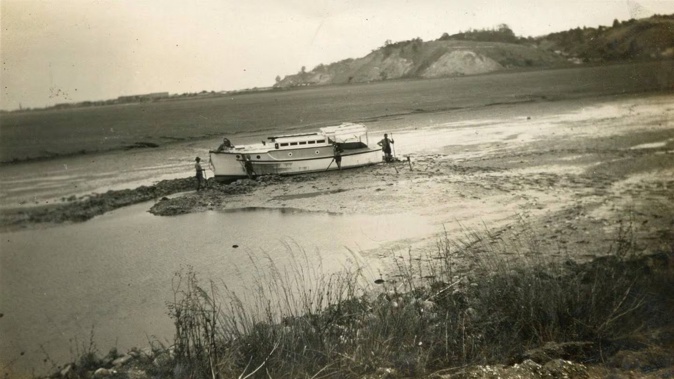
Scientists have shed new light on how a future major earthquake could transform large areas of Napier’s coastline – finding it’d most likely sink land, rather than raise it up as happened in 1931′s devastating event.
Their just-published insights offer thousands of years of geological context for that 7.8 quake, which was shown to have caused effects much different to similar-scale events thousands of years before.
At the same time, they’ve helped scientists build a better picture of the Hikurangi Subduction Zone – the vast plate boundary that represents our largest fault zone – in a part of the country where its behaviour is understood least.
Subduction zones have been responsible for some of the biggest cataclysms in history – as seen in Japan in 2011 and the Indian Ocean in 2004 – and there’s geological evidence to show such events have unfolded here and will do again.
Scientists recently estimated a 26 per cent chance of a quake 8.0 or larger striking beneath the lower North Island within the next 50 years.
While they now had a good handle on past activity at other sections of the Hikurangi margin, this hadn’t been so clear in Hawke’s Bay, beneath which the subduction zone dipped westward.
/cloudfront-ap-southeast-2.images.arcpublishing.com/nzme/4OUXNHJES4D6SWRM5BND7MVI4U.jpg)
The Hikurangi Subduction Zone marks the margin where the the Pacific Plate dives - or subducts - westward beneath the North Island. Image / GeoNet
Study co-author Dr Kate Clark said the region was known to host engimatic “slow slip” earthquakes thought to help gradually relieve pent-up tectonic energy, while there was less ability for plates to lock and build pressure that could be unleashed in a huge quake.
Yet this notion of lower risk didn’t stack up with earlier work at Ahuriri Lagoon, near Napier, which showed the coastline had repeatedly subsided – a tell-tale sign of big subduction zone events.
To investigate this geological mismatch, the team turned to another site just north of the city, at Pakuratahi Valley, where they examined signs of sharp change buried amid some 5000 years of marine sediments.
Using these hidden clues and radiocarbon dating, they found evidence for five large earthquakes – all of which transformed the coastal environment.
In most cases, the land dropped downward suddenly; one event, dated around 1000 years ago, was also big enough to trigger a large tsunami.
/cloudfront-ap-southeast-2.images.arcpublishing.com/nzme/YFVQASA4PVHVHA5G6XXZJER52I.jpg)
At this site in the Pakuratahi Valley, just north of Napier, researchers from GNS Science and Victoria University found geological evidence for five major earthquakes in the last 5000 years. Their analysis suggests the next major earthquake in the region could sink local coastal land, rather than raise it, as happened in the 1931 Napier Earthquake. Photo / GNS Science
In another event around 3600 years ago, however, the land was hoisted up.
Interestingly, that quake occurred on the same fault – the Awanui – that triggered the Napier Earthquake, in which areas north of the city, including the land its airport sits upon, were also uplifted.
As well, the new data enabled the scientists to calculate the interval between big quakes on the fault: found to be a very long 3000 years.
When the team combined all the large prehistoric quakes they’d discovered at both sites, six out of nine involved the land sinking.
While the last three of those involved uplift, they concluded the next cataclysm was still more likely to result in subsidence.
“The average interval between these large subsidence-causing earthquakes is relatively long though at around 1300 years but they are quite irregular in timing,” said the study’s lead author, Dr Charlotte Pizer of Victoria University.
“The intervals between these earthquakes have been as little as a few hundreds of years, and up to 3000 years or more - this irregular earthquake behaviour makes giving a probability or forecast of a future earthquake quite challenging.”
What was clear, however, was the major problems such an event would cause for Napier and its northern coastlines.
/cloudfront-ap-southeast-2.images.arcpublishing.com/nzme/LRPTBHKETFEDNGWJCIZWYODCVI.jpg)
Hawke's Bay Airport, north of Napier, sits upon land that was uplifted in the 1931 Napier Earthquake. Photo / Warren Buckland
“It may enhance coastal erosion, change the effectiveness of flood defences and coastal drainage, and impact infrastructure like coastal roads and the airport,” Pizer said.
“Minor amounts of subsidence may be unnoticeable but amounts more than a few tens of centimetres could have considerable impact.”
The team now planned to check if those subsidence-causing quakes indeed occurred on the subduction zone – and if so, whether they represented the same quakes identified further south on the margin.
“Ultimately, this helps us understand the size and magnitude of past earthquakes on the subduction zone, providing a more informed perspective of Aotearoa’s largest source of seismic hazard and the likely impacts of the earthquakes it may produce in the future,” said co-author Dr Jamie Howarth, of Victoria University.
As Hawke’s Bay recovered from the devastation of Cyclone Gabrielle, Clark said the new findings also highlighted the need to consider other future natural hazards in the region.
“We particularly encourage people to self-evacuate to high ground or as far inland as possible if they are near the coastline when they feel long or strong shaking,” she said.
“People can check their tsunami evacuation zones on the Hawke’s Bay Emergency Management website.”
Jamie Morton is a specialist in science and environmental reporting. He joined the Herald in 2011 and writes about everything from conservation and climate change to natural hazards and new technology.
Take your Radio, Podcasts and Music with you









